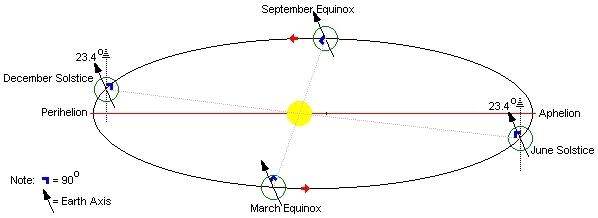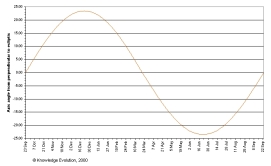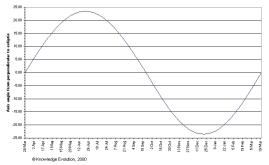| Solstices and Equinoxes | Melbourne | Toronto |
Because the Earth's axis is directed at the same point in space as it revolves around the Sun, the angle of tilt of the axis with respect to the Sun varies, from a minimum of 0 degrees (which defines the equinoxes) to a maximum of 23.4 degrees toward or away (which defines the summer and winter solstices, respectively).
The subsolar point is the point on the Earth's surface where the Sun's radiation strikes at a 90 degree angle; alternatively it is the point on the Earth where the Sun is directly overhead at noon.
| June Solstice | Equinoxes | December Solstice | ||
| Subsolar point | Tropic of Cancer | Equator | Tropic of Capricorn | |
| 23.4 degrees N | 0 degrees | 23.4 degrees S |
Because the Earth's orbit is slightly elliptical, there is a point on the orbit where the Earth is further away from the Sun than at any other time (Aphelion, ~July 4) and a point approximately opposite on the orbit where the Earth is closer to the Sun than at any other time (Perihelion, ~Jan 3).
 |
The UTC values for equinoxes and solstices were obtained from the US Navy web site.
An explanation of Coordinated Universal Time (UTC), which approximates to Greenwich Mean Time (GMT), is available here.
| Melbourne, Australia: | Longitude: 145° 08' East |
| Event | December Solstice | Mon, 22 Dec 2025, 2:03 AM AEDT |
GMT values have been converted to Australian Eastern Standard Time (GMT + 10), and are shown below:
Note: Add 1 hour to obtain correct local times for the December Solstice and March Equinox for the states in Australia that change to Australian Eastern Daylight Time during the warmer months.
| March Equinox
Autumn |
June Solstice
Winter |
September Equinox
Spring |
December Solstice
Summer |
Number of times for a particular date:
A better idea of the relative frequencies for particular Melbourne dates over a 142 year period are shown here.
| Toronto, Canada: | Longitude: 79° 22' West |
| Event | December Solstice | Sun, 21 Dec 2025, 10:03 AM EST |
GMT values have been converted to Eastern Standard Time (GMT - 5), and are shown below:
Note: Add 1 hour to obtain correct local times for the March Equinox, June Solstice and September Equinox for the areas that change to Eastern Daylight Time during the warmer months.
| March Equinox
Spring |
June Solstice
Summer |
September Equinox
Autumn |
December Solstice
Winter |
Number of times for a particular date:
A better idea of the relative frequencies for particular Toronto dates over a 142 year period are shown here.
| Links to other detailed observations and explanations:
Perihelion and Aphelion (Time and Date) Milankovitch Cycles (NASA) |

